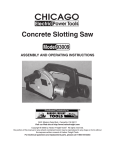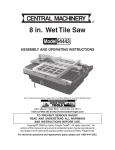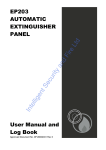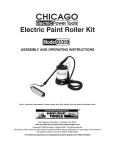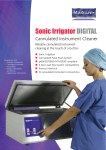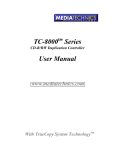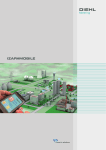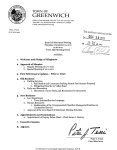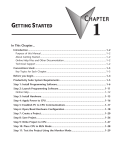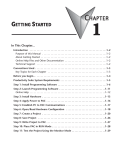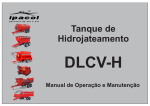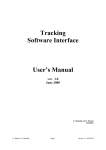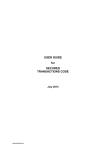Download The Computer Age, Programming
Transcript
The Computer Age Programming - Why and How? by Harry Coupland, OLS, George Brown College of Applied Arts and Technology, Toronto If you are like me then you probably find yourself with Grade 13 education of a few years ago somewhat baffled by the current level of technical papers. They seem to require a knowledge of calculus, statistics, electronics and geodesy. While not meaning to suggest that these subjects are unnecessary or that we are uneducated or slow, it does seem more realistic to admit our weak nesses and try to apply our own educa tion and experience to the newer tech nologies. One such technology may be found in the field of computers. Whereas most surveyors are now using computers of one sort or another, I think that they are a little mystified by it all. It is my intention to show that with only common sense and your own back ground in survey mathematics you can easily learn enough about computer sys tems and languages to enable you to write ail your own programs and thereby be less dependent on the firm s that sell you the hardware in the first place. We ourselves got into this approach quite by accident. Ever since the incep tion of the survey technician program in 1965, it was our wish to purchase a programmable type of calculator but, budgets being what they are, we never got beyond the wishing stage. I am glad now that we never acquired such a machine because our school made the major decision to put in a complete time-sharing computer system. We are now extremely flexible and find ourselves in the position of having the latest im provements to the system always avail able. Certainly, if we had purchased one of the sim pler machines a few years ago, we would now be looking for a more improved model. Time-sharing is based on the fact that the computer is capable of such fantastic speeds, and that it can handle the work load from several people at one time. The configuration of such a system finds a central data processor at some loca tion which is connected by regular tele phone wires to a series of remote ter minals. These remote units are usually teletypew riters sim ilar to those used in the telecom m unications field and in fact can be used for the same purpose. However, other pieces of equipment can be used such as cathode ray tubes or plotters. Most of the 30 or so remote term inals at George Brown College are connected to the GE 400 com puter (now Honeywell) by dialing the com puter num ber on a regular telephone. When the proper signal is heard the hand set is placed on a cradle which translates the electronic signals into sound signals to be sent over the wires. In the survey section we have decided to use hard-wired term inals instead because of their more refined signal and excellent Bell service. Our term inals are complete with tape punch and reader. This type of terminal can be rented for around $115 per month and can be used as a regular telephone or for tele communications. In addition, time must be rented from a firm which owns the computers. I am uncertain as to this cost. The actual method of calculation of a survey job as we recommend to our students is described below: (1) Prepare a field sketch and num ber ail required points. (2) W rite up a list of commands on ordinary paper that correspond to the program used. We use a program developed by us called “ Survey.” (3) Prepare a paper tape of this list on the terminal in the local mode. This operation is entirely free of cost and is the most time con suming part of the operation. (4) Proof read the tape. (5) Dial up the computer. After acces sing the com puter you must type in your user number and a secret password or the com puter will break the connection. (6) A file is created and the tape is fed to the computer. This file is then saved and will now contain a permanent listing of the program commands. Let us refer to this as FILE #1. (7) A second dummy file referred to here as FILE #2 is created and — 22 — saved. This w ill be used liater to store the co-ordinates if required. (8) The actual program “ Survey” (or other) is accessed and asked to RUN. (9) At the appropriate places certain questions w ill be typed by the com puter. These must be an swered by the correct response. The questions are kept to a m ini mum as they tend to slow the machine down considerably. The most usual question is FILE NAME? or NEXT FILE? In our current case we would type FILE #1 to the question FILE NAME? The com puter would then carry out the list of instructions included in FILE #1. Answers may or may not be printed depending on the operator’s earlier instruction. To the question NEXT FILE? the response could be one of many but it is usual to end a run with the word STORE. This w ill enable the operator to store the infor mation for recall at any time. In this case all the calculated co ordinators would be stored in FILE #2. The word NONE to the question NEXT FILE? w ill cause the com puter to exit the program. (10) If the work in FILE #1 is without error and is no longer required it is removed from permanent stor age by the word UNSAVE. (11) If the list of co-ordinates in FILE #2 are required they are listed. (12) Ail work com pleted, the line is disconnected by typing BYE. Obviously this does not describe fully the complete operation. A sample job is shown elsewhere. It is my opinion that a time-shared com puter system has enough advan tages over the program mable calculator method that it should be carefully con sidered before acquiring any new hard ware. It is not my intention, however, to sell com puter time, and as I have not yet reached my goal in this article, I had better get down to brass tacks. It is a foregone conclusion that most (continued on page 23) Programming — W hy and How (continued from page 22) of us are using a com puter of one kind or another. Who, though, is doing your calculations and I do mean who is pushing the buttons? If you are using Co-Go, it is a group from M.I.T. Is it a tape deck or a card supplied by the manufacturer or another program supplied by a soft-ware company? If so, there is a strong chance that you have not seen the program, you do not know how it works and you are unable to modify it to suit your needs. If this makes you feel that you have turned your cal culations over to hirelings and you are on longer in control but that the machine is beginning to rule your life then I strongly suggest that you learn a com puter language. I do not think that it particularly matters which language but I myself have a preference for BASIC as that is the language with which I am most fam iliar. With no more than four hours of instruction, we at George Brown have developed several programs, all written in BASIC, which do all kinds of work. Some of these are as follow s: COROTE — rotates and moves co ordinates from one axis to another. (Ed. Note — Law and Surveying (continued from page 17) Sacred 66 A further exam ple of this strange phenomenon was observed, again during my form ative years, surveying in northern Ontario, where posts planted during the original survey (Circa 1900) may still be found in place, the scribed lettering still legible. Imagine if you will, the surveyor having found an original post marking a lot corner, carefully cross referencing the centre of the post before replacing it to the nearest hundredth of a foot with a standard iron bar. He would then proceed to the intersection of two road allowances where, on finding two original posts on opposite sides of the inter section, he would measure between them only to discover that they were 63 feet apart rather than the sacred 66. W ithout any apparent pangs of conscience, he replaced one o f the posts with great precision sum m arily yanked out the other and planted an S. I. B. 66 feet from the first. The moral (if such is the term) to be drawn from these anecdotes has two elements. The first is that roads are not necessarily the same width as m ight be indicated by the plan of survey that creates them. The second suggests that the unalterable status of original monu ments is not fu lly understood. Re-establish Lim it To pursue the matter a bit further, CO PLOT — plots a co-ordinate file on the teletypew riter by a series of asterisks to within on e/tw elfth of an inch. CURVAL — calculates curve align ment problems — gives all curve data and stake out information. SURVEY — closes, balances, cal culates new points, de termines areas; in short, does all usual survey calculations. You too, can learn in a very short time enough programming to solve all your usual survey problems, calculate your payroll, keep a status file on current jobs or even play noughts and crosses with the kids. If you would like a copy of any of the above programmes or a user’s manual for SURVEY, please drop us a line and we will be glad to send them out. There is no charge and you are com pletely free to chop and change as you see fit. The address is Harry Coupland, O.L.S., George Brown College of Applied Arts and Technology, 51 Teraulay Street, Toronto, Ontario. Illustrations fo r the article are on pages 24, the question arises as to the manner of re-establishing street lim its after the original evidence has disappeared. The responses must sound redundant and w ill come as no surprise — the lim it must be re-established from the best available evidence of its original location. If any conclusions may emerge from this dissertation, surely the most pro minent would be the acknowiedgm ent that I have barely scratched the surface of the philosophy I set out to examine. The status and affect of conventional lines, surveys by unqualified surveyors, fences, and lines by parol agreement, etc. come to mind and with the kind fo r bearance of publisher and reader, we may examine some of these in future Quarterlies. G uest Editorial (continued from page 3) acceptable, practical experience. We cannot understand why the A.O.L.S. Council is so reluctant to investigate and evaluate our Program. We intend to demonstrate to business, industry, prospective students, parents, alumni and the general public the uniqueness of Ryerson and the kind of education it offers. Our program is and w ill be open for further comments and improvements, and we would appreciate receiving from you any remarks or suggestions in order that revisions, if necessary, may be made. — 23 — A SAMPLE SURVEY JOB In order to illustrate our method of computation using the program “ Survey” we enclose the following pages: Page 1 — a sample page of notes with all necessary points numbered. Page 2 — the two input files — Coup 2 for set up — Coup 3 for lim its and area. Page 3 — the results of a computer run showing limits and area. Page 4 — a. listing of the final co ordinates taken from file Coup 1. It is interesting to note that the time required to set up and prepare the inputs for his job was approximately one hour. This compared with 7 minutes of real time to run but only 24 seconds of computer time to compute. Obviously a typist could save even more time. In cidentally, the errors that occur are usually the same errors that one would find if the job was calculated in the conventional manner; i.e. wrong quad rant, transposition of figures, or data left out. i, 26 and 27) Regional Group News (continued from page 21) of the subdivision. J. G. O’Grady, a solicitor having a great deal of experience in property law and a background including experience in the land titles office at Toronto, spoke on possessory boundaries, stressing not only the period of time over which the possession had been in existence, but also its character and the fact there can be no break in the time, that is the posession must be every day for 10 years with no break even for one day. Mr. O’Grady supported his talk with judge ments handed down by the Courts regarding possessory boundaries and also in some cases, judgements handed down by the Appeal Court. As Mr. O’Grady pointed out, it was interesting to note the high percentage of successful appeals. G. MacKay of the Director of Titles Office, spoke on water boundaries, he also included in his address, judicial decisions on some of the more interest ing cases he had encountered. After a lunch break, the meeting resumed with the three speakers forming a panel and answering questions from the floor. This proved to be quite a lively afternoon session. We were very fortunate to secure speakers of the cailbre we did and we thank these men fo r giving up the time necessary to make the meeting a success. 2o' n FILE iMAM E: SURREY R EADV RUNNH P R I N T ALL ? F I L E KA-1E ? 0 C0UP2 CLOSURE F R 0 M 6 ERROR=ONE PART N 6 7 42 TO6 PER 2347 8 5 35 W 2 . 4 8 0 3 2 8 I E - 3 -6 * 0505867 E - 3 M.01 CONTI NUE ? 1 CHECK T I E 1 0 - 8 S 6724 6 W -V 2 7 8 . 3 6 USE L I N E FOR NEXT C A L CU L AT I O N 15 - 16 N 27 5-6 4V E ^0 .3 7 ARC ^0 .39 RADI US 3 67 .00 RADIUS 12^5 .92 RADIUS R A D I US R ADI US 1 (/) 4 5 . 9 2 NEXT F I L E ? L? 4 ? 16 17 1 31 0 4 0.0 6 4 .6 1 NEXT F I L E ? CO UP 3 L I M I T S OF PART ONE 1 7 - 19 S 33 8 32 £ 171 . 2 6 19 - 18 S 33 8 32 E 52 . 9 ^ 18 - 12 s 52 7 16 E 188 . 0 6 ARC 188 . 2 12 - 1 1 0 W s 67 2 5 84 .54 11 - 13 s 67 25 0 Af 1^1 . 4 1 12 - 13 s 67 2 5 0 W 2 2 5 . 9 6 13 - 2 6 N 55 51 3 5 4 10 1 . 7 2 ARC 101.76 26 - 1 4 iM 6 0 3 2 22 4 ARC 69 . 0 9 6 9 . 08 14 .iM 1 1 17 19 E 16 253.37 248 .37 ARC 4 16 - 17 N 3 1 0 E 6 4.61 AREA OF PA R T ONE ALONG CHORDS AREA OF 6 S I DED F I GUR E= 6 4 5 4 8 . 9 9 S Q . F T . OR 1 . 4 8 1 8 4 0 9 SUBTRACT F O L L O WI N G AREA OF SEGMENT 13 14 I S 396 ,ADD F O L L O W I N G AREA OF SEGMENT 14 16 IS 3606 ADD F O L L O W I N G AREA OF SEGMENT 18 12 IS 445 9.9 SECS RUNNI NG SQ.FT. OR 9 . 1 1 0 0 8 6 6 E - 3 ACRES .3353 SQ.FT. OR 8 . 2 79 0 0 6 7 (•> 2 ACRES .59062 SQ.FT. OR 1 . 0 2 2 9 3 5 3 E - 2 ACRES ? NONE TIME: ACRES .83537 NEXT F I L E ? STORE S T O R E I K ? COUP1 STORED NEXT F I L E 10 4 5 . 9 2 36 7 . 0 0 I/O TIME THE RESULTS OF A RUN — 25 — 2 12.5 SECS OL D : C OU P S READY L I S T NH 80 5 0 CLOSURE F R 0 M 6 1 0 6 90 ! 6 1 0 0 0 0 1 0 0 0 0 10 0 13 6 6 7 1 10 6 73 67 35 0 346.53 120 7 8 4 29 25 0 245 130 8 9 4 22 2 5 0 2 3 2 . 8 5 1 40 9 4 1 31 0 4 0 79.3 8 1 50 4 5 2 7 9 2 2 4 0 1 9 9 . 5 6 16 0 5 10 2 37 5 5 0 1 7 6 . 9 1 1 7 0 13 6 2 3 7 5 5 0 2 5 5 . 0 9 1 7 5 5 0 CHECK T I E 1 80 2 10 8 , 1 90 4 5 3 4 7 9 2 2 40 4 3 3 . 7 1 2 0 3 1 1 3 5 1 90 0 0 1 1 4 5 . 9 2 20 5 1 31 0 4 0 0 2 0 1 5 4 2 1 0 12 2 0 9 2 90 0 0 4 0 0 2 2 3 4 8 21 2 2 2 2 5 0 2 0 2 3 0 4 21 2 2 1 6 7 2 5 0 4 0 0 2 4 0 2 0 5 10 21 2 2 1 1 250 8 1 11 13 1 0 4 5 . 9 2 3 6 7 2 5 0 260 81 22 12 1 2 4 5 . 9 2 3 6 7 2 5 0 270 5 1 2 14 10 4 5 . 9 2 3 6 7 280 5 1 2 15 1 2 4 5 . 9 2 36 7 2 90 4 2 3 16 2 5 8 5 6 0 33 3 0 0 9 1 15 1 8 1 2 4 5 . 9 2 2 0 0 3 1 5 5 0 USE L I N E FOR NEXT C A L C U L A T I O N 3 2 0 3 15 16 3 6 7 READY OL D: COUP 3 O IL 7 /H C , READY L I S T NH 1 1 1 54 2 5 1 10 4 3 45 200 2 20 5 2 5 1,8 1 7 1 9 3 8 1 5 26 1 0 4 5 . 9 2 3 31 21 10 4 5 0 L I M I T S OF PA R T ONE 5 2 17 1 9 2 1 9 1 8 3 1 8 12 1 2 4 5 . 9 2 6 2 12 1 1 2 1 1 1 3 2 12 1 3 3 13 26 7 3 2 6 1 4 1 0 4 5 . 9 2 3 14 16 3 6 7 2 16 8 5 0 AREA OF PART ONE ALONG CHORDS 9 1 4 6 12 13 1 4 16 17 1 8 10 50 S UB T RA CT F O L L O W I N G 11 15 13 1 4 1 0 4 5 . 9 2 12 50 ADD F O L L O W I N G 13 1 5 1 4 16 36 7 14 50 ADD F O L L O WI N G 15 15 1 8 12 1 2 4 5 . 9 2 ACTUAL F I L E S — 26 — L I 'm , 7 5 H c/Z cr / 1045.92 17 COLC L t M / T S caic ULUS G O U P l READY L I S T NH 1 2 1 1 1 1 2 I 1 3 4 5 929 A .470 10275.816 10420.753 1037 7 . 5 9 2 10340 .806 6 10 0 0 0 . 0 0 0 1 0000 . 0 0 0 7 8 1 1 1 9 ! 9 10 11 12 1 1 1 1 10 11 12 986 7 . 8 55 10094 .342 10309.59 7 10 20 1.24 1 101/84.881 102 1 7 . 3 4 8 10130 .574 1 0 2 2 1 .6 37 10429.526 10 A 6 5 . 2 0 1 10520 .543 1 0 3 3 2 .8 1 4 10 3 7 7 . 1 4 4 10 4 8 2 . 2 3 0 10075 .853 1 0 2 2 9 . Ah A 10511.605 10187.662 96 79 . 6 5 4 9586 .225 9497 . 429 9843 .244 9855 .988 9 9 3 4 . 0 49 9 7 2 5 .417 9 581 . 0 7 9 9 6 10 . 7 9 8 9629 • 698 966 3 .0 3 9 9 7 8 5 .6 1 5 9 7 56 • 6 7 0 96 0 1 . 4 3 1 9593 .852 9963 .18 1 9838 .588 96 4 1 . 2 2 5 3 4 5 6 7 13 14 15 16 17 18 19 20 2 1 22 23 24 l 1 1 1 1 1 1 1 1 1 1 8 13 1A 15 16 17 IS 19 20 21 22 25 26 9097 9944 9308 9 538 9 7 34 ABOVE — 27 — . 02 3 .058 .253 .392 .531






